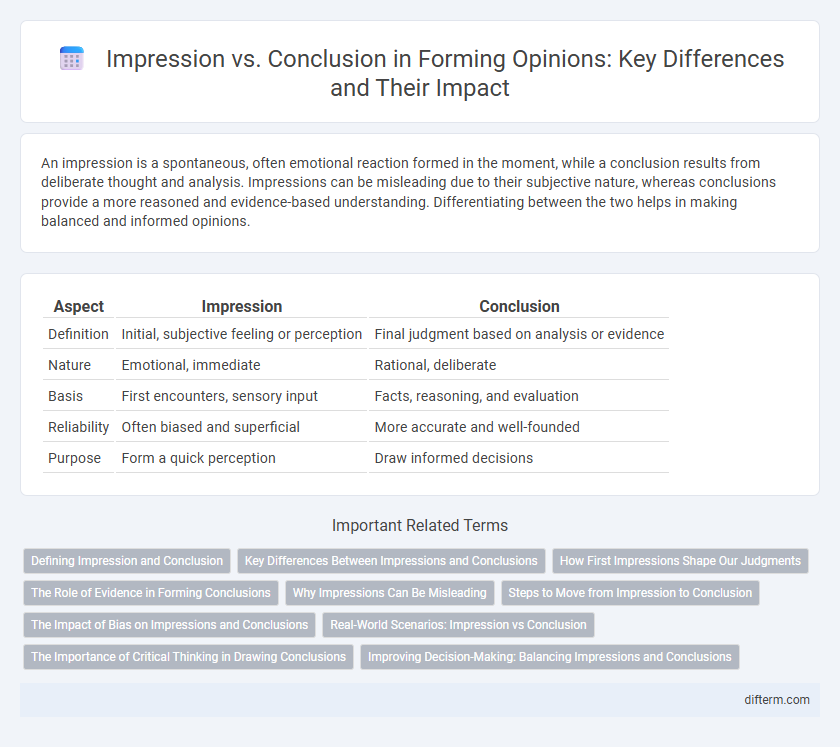An impression is a spontaneous, often emotional reaction formed in the moment, while a conclusion results from deliberate thought and analysis. Impressions can be misleading due to their subjective nature, whereas conclusions provide a more reasoned and evidence-based understanding. Differentiating between the two helps in making balanced and informed opinions.
Table of Comparison
| Aspect | Impression | Conclusion |
|---|---|---|
| Definition | Initial, subjective feeling or perception | Final judgment based on analysis or evidence |
| Nature | Emotional, immediate | Rational, deliberate |
| Basis | First encounters, sensory input | Facts, reasoning, and evaluation |
| Reliability | Often biased and superficial | More accurate and well-founded |
| Purpose | Form a quick perception | Draw informed decisions |
Defining Impression and Conclusion
An impression is an initial, often subjective perception formed quickly based on limited information, capturing immediate feelings or reactions. A conclusion is a reasoned judgment derived from analyzing evidence and logical evaluation, offering a more definitive understanding. Distinguishing between impression and conclusion helps clarify decision-making and communication processes.
Key Differences Between Impressions and Conclusions
Impressions are immediate, subjective reactions formed through sensory experiences, while conclusions are reasoned judgments based on analysis of evidence. Impressions often lack comprehensive evaluation and can be influenced by emotions or biases, whereas conclusions rely on critical thinking and logical reasoning to synthesize information. Understanding these key differences helps in distinguishing intuitive responses from well-founded decisions in decision-making processes.
How First Impressions Shape Our Judgments
First impressions influence our judgments by quickly activating cognitive biases and emotional responses that shape how we perceive others. These initial perceptions often become cognitive anchors, making it challenging to adjust our views even when presented with new information. Understanding the power of first impressions highlights the importance of mindfulness in evaluating people and situations objectively.
The Role of Evidence in Forming Conclusions
Impressions often arise from initial perceptions and subjective feelings, whereas conclusions rely heavily on the systematic evaluation of evidence and facts. Reliable evidence serves as the foundation for forming well-grounded conclusions, minimizing biases that typically influence impressions. A critical assessment of data ensures that conclusions remain logical, verifiable, and distinct from superficial impressions.
Why Impressions Can Be Misleading
Impressions often rely on immediate sensory input and emotional reactions, which can distort the true nature of a situation or person. Cognitive biases, such as confirmation bias and the halo effect, frequently influence these initial judgments, leading to inaccurate or incomplete assessments. Unlike conclusions, which are drawn from deliberate analysis and evidence, impressions are vulnerable to superficial factors and fleeting circumstances.
Steps to Move from Impression to Conclusion
Transforming an impression into a well-founded conclusion requires systematic analysis and critical evaluation of available evidence. Begin by gathering relevant data to verify initial perceptions, then apply logical reasoning to assess consistency and validity. Finally, synthesize findings to formulate a reasoned, objective conclusion grounded in verified information.
The Impact of Bias on Impressions and Conclusions
Bias significantly shapes both impressions and conclusions by filtering information through preconceived notions and stereotypes. Impressions often form quickly and subconsciously, making them more susceptible to bias and potentially misleading initial judgments. Conclusions, ideally drawn from critical analysis, still risk being skewed if underlying biases remain unexamined, leading to flawed decision-making and distorted realities.
Real-World Scenarios: Impression vs Conclusion
In real-world scenarios, an impression forms rapidly based on initial sensory input and emotional reactions, while a conclusion results from deliberate analysis and evidence evaluation. Impressions may lead to cognitive biases that distort judgment, whereas conclusions rely on critical thinking and systematic reasoning for accuracy. Understanding the distinction can improve decision-making effectiveness in both personal and professional contexts.
The Importance of Critical Thinking in Drawing Conclusions
Impressions often form based on immediate perception and emotion, whereas conclusions require careful analysis and evaluation of evidence. Critical thinking enables individuals to move beyond superficial impressions and rigorously assess information to arrive at well-founded conclusions. Developing this skill is essential for avoiding cognitive biases and making informed decisions.
Improving Decision-Making: Balancing Impressions and Conclusions
Impressions often form rapidly based on limited information, shaping initial attitudes that can bias decision-making processes. Integrating well-analyzed conclusions, derived from comprehensive data and critical thinking, enhances the accuracy and reliability of decisions. Balancing intuitive impressions with evidence-based conclusions fosters more informed and effective choices in complex situations.
impression vs conclusion Infographic

 difterm.com
difterm.com